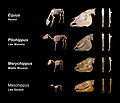Equidae
Equidae is a family of mammals in the order Perissodactyla, which includes horses, donkeys, and zebras. The family is known for its unique characteristics, such as long legs adapted for speed, and a single hoof on each foot.
Characteristics[edit]
Members of the Equidae family are known for their distinctive physical characteristics. They have long legs, which are adapted for speed, and a single hoof on each foot. They also have long, slender bodies, and a large, well-developed brain. The teeth of equids are adapted for grinding plant material, and they have a complex digestive system that allows them to extract nutrients from fibrous plants.
Evolution[edit]
The Equidae family has a long evolutionary history, with the first equids appearing in the early Eocene, around 54 million years ago. These early equids were small, forest-dwelling animals that were adapted to a browsing diet. Over time, equids evolved to become larger and more adapted to a grazing diet, with changes in their teeth and digestive system to allow them to process grasses more efficiently.
Species[edit]
The Equidae family includes several species, including the horse (Equus caballus), the donkey (Equus asinus), and several species of zebra, including the plains zebra (Equus quagga), the mountain zebra (Equus zebra), and the Grevy's zebra (Equus grevyi).
Conservation[edit]
Several species within the Equidae family are threatened with extinction, due to habitat loss, hunting, and competition with livestock. Conservation efforts are underway to protect these species and their habitats.
See also[edit]
Ad. Transform your life with W8MD's Budget GLP-1 injections from $75


W8MD offers a medical weight loss program to lose weight in Philadelphia. Our physician-supervised medical weight loss provides:
- Weight loss injections in NYC (generic and brand names):
- Zepbound / Mounjaro, Wegovy / Ozempic, Saxenda
- Most insurances accepted or discounted self-pay rates. We will obtain insurance prior authorizations if needed.
- Generic GLP1 weight loss injections from $75 for the starting dose.
- Also offer prescription weight loss medications including Phentermine, Qsymia, Diethylpropion, Contrave etc.
NYC weight loss doctor appointmentsNYC weight loss doctor appointments
Start your NYC weight loss journey today at our NYC medical weight loss and Philadelphia medical weight loss clinics.
- Call 718-946-5500 to lose weight in NYC or for medical weight loss in Philadelphia 215-676-2334.
- Tags:NYC medical weight loss, Philadelphia lose weight Zepbound NYC, Budget GLP1 weight loss injections, Wegovy Philadelphia, Wegovy NYC, Philadelphia medical weight loss, Brookly weight loss and Wegovy NYC
|
WikiMD's Wellness Encyclopedia |
| Let Food Be Thy Medicine Medicine Thy Food - Hippocrates |
Medical Disclaimer: WikiMD is not a substitute for professional medical advice. The information on WikiMD is provided as an information resource only, may be incorrect, outdated or misleading, and is not to be used or relied on for any diagnostic or treatment purposes. Please consult your health care provider before making any healthcare decisions or for guidance about a specific medical condition. WikiMD expressly disclaims responsibility, and shall have no liability, for any damages, loss, injury, or liability whatsoever suffered as a result of your reliance on the information contained in this site. By visiting this site you agree to the foregoing terms and conditions, which may from time to time be changed or supplemented by WikiMD. If you do not agree to the foregoing terms and conditions, you should not enter or use this site. See full disclaimer.
Credits:Most images are courtesy of Wikimedia commons, and templates, categories Wikipedia, licensed under CC BY SA or similar.
Translate this page: - East Asian
中文,
日本,
한국어,
South Asian
हिन्दी,
தமிழ்,
తెలుగు,
Urdu,
ಕನ್ನಡ,
Southeast Asian
Indonesian,
Vietnamese,
Thai,
မြန်မာဘာသာ,
বাংলা
European
español,
Deutsch,
français,
Greek,
português do Brasil,
polski,
română,
русский,
Nederlands,
norsk,
svenska,
suomi,
Italian
Middle Eastern & African
عربى,
Turkish,
Persian,
Hebrew,
Afrikaans,
isiZulu,
Kiswahili,
Other
Bulgarian,
Hungarian,
Czech,
Swedish,
മലയാളം,
मराठी,
ਪੰਜਾਬੀ,
ગુજરાતી,
Portuguese,
Ukrainian







